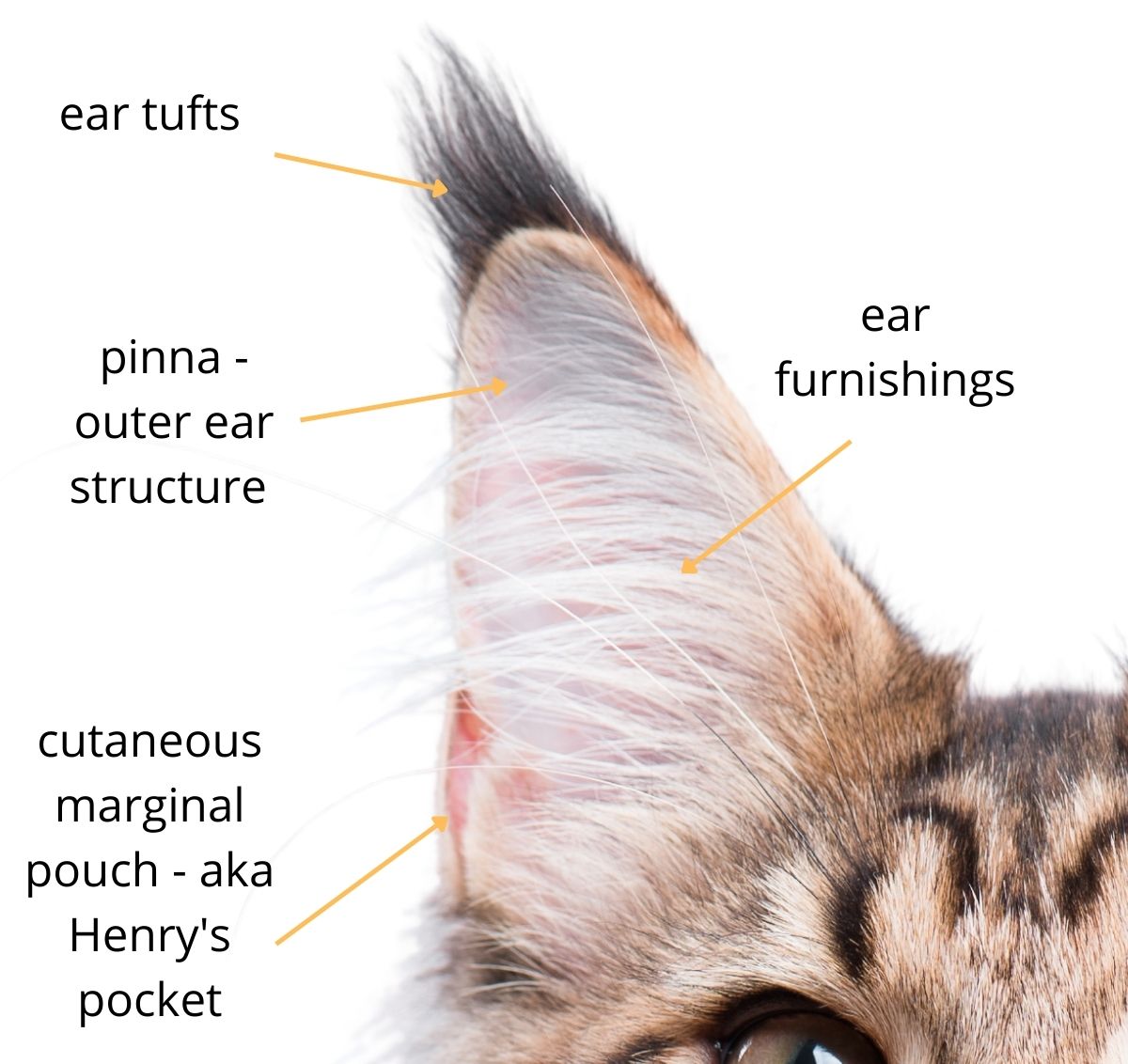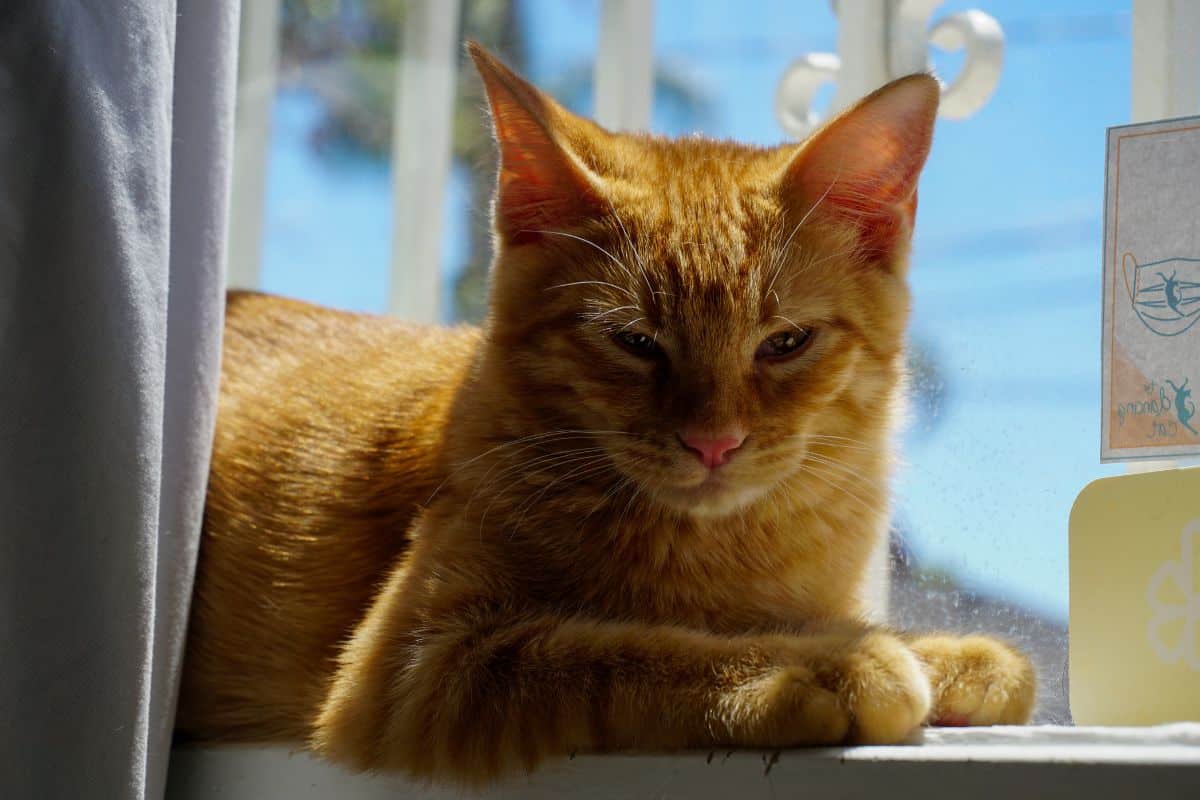Cats have an amazing hearing ability. They can hear better than humans, dogs, and many other animals as well.
A cat’s hearing has evolved over time to be able to pick up high-pitched frequencies and to pick up sounds from far away in order to help them be better hunters as well as to help them keep themselves safe from their own predators.
Now, as house pets, cats don’t necessarily need their hearing to capture their food per se, but it does help them know when the family dog is trying to sneak up on them!
Anatomy of a cat’s ears
The part of the cat’s ear that is easily visible to humans is called the pinna. The pinna is what we generally just refer to as the ear, or the outer portion of the ear that sits atop the cat’s head. The pinna, in most cats, is typically cone-shaped and upright.
Thanks to their shape, the pinna or the cat’s ears act like a funnel, allowing sound waves to travel the cat’s ear canal. In fact, as you may have already noticed, cats are able to move their ears both together and individually, to get better access to the sound waves.

Cats have 32 muscles to control their ears
Have you ever noticed a cat twitching its ears or one ear suddenly sticking up straighter than the other? If you have, the cat was using its ear muscles to hear better! In fact, cats have thirty-two muscles in each of their ears, whereas dogs only have about eighteen and humans have six.
These muscles allow cats to move their ears independently of each other. They can even move their ears up to 180 degrees. Doing so helps cats better isolate sounds and determine the direction the sounds are coming from as well as interpret what the sound is.
So, when you see a cat twitching its ears or moving them in what seems like a random way, chances are they are actually trying to pinpoint where exactly a certain sound is coming from!

Internal anatomy of a cat’s ear
Now that we have talked a little about the outer ear, the part we can see, let’s discuss the internal anatomy of a cat’s ear and why cats can hear so well. From the outer ear, the ear canal leads the way to the middle ear.
The ear canal of cats is actually quite different from the ear canal of humans and is part of the reason they can hear so well. A cat’s ear canal is much more tapered and deeper than a human’s ear canal. This anatomical design helps sound travel better to the middle ear, where the eardrum is located.
In addition to the eardrum, the middle ear also contains a small air-filled chamber that contains three tiny bones, two muscles, the oval window (a connective tissue membrane), and the Eustachian tube, which allows air to enter the middle ear to fill the chamber containing the tiny bones.
The tiny bones include the hammer, the anvil, and the stirrup and are called ossicles. These bones actually vibrate in response to sound waves coming from the outer ear and then send those signals to the inner ear.
The inner ear comes next and is deep inside the skull of a cat. It contains the cochlea, the structure responsible for receiving and sending messages to the brain or telling the brain what the ears are hearing.
Thanks to the overall way their ears are designed, cats are actually able to amplify sounds up to two to three times for frequencies within the 2,000 to 6,000 Hertz range.
How does a cat’s hearing compare to dogs and humans?
So how exactly does our hearing and the hearing of dogs compare to the hearing of cats?
Well, at certain frequencies, human ears and cat ears hear about the same. Up to about 20,000 Hertz (the unit of frequency describing one cycle per second), cats and humans can hear about the same as one another. However, the differences between them and us become very clear as the frequencies rise.
Humans and cats can both hear anything from 20 Hertz to about 20,000 Hertz. However, anything beyond the 20,000 Hertz mark can become very difficult for people to hear. Cats, however, can hear sounds as high as 64,000 Hertz.
Cats can hear even better than dogs, who can only hear until about the 45,000 Hertz range.
Additionally, thanks to the anatomy of their ears, cats can differentiate between sounds that are as close as one-tenth of a pitch to each other. Being able to differentiate between pitches allows them to more easily determine the precise location the sound is coming from and how far away it is.
Amazingly, cats can also hear sounds that are four to five times farther away than what humans can hear.
In addition to all this, as hunters, cats need to be able to quickly determine where a sound is coming from before their prey gets too much of a chance to scurry away.
For example, if a cat is three feet away from the location a sound is coming from, it will only take a cat about 0.06 seconds to pinpoint almost exactly where the sound is coming from within just a few inches! This allows a cat to pounce on its prey without even using its eyes to locate the target prey!
Cat’s ears role in balance
Here is a fun fact you may not have heard. Cats’ ears aren’t only meant for hearing! They also help cats maintain their balance.
Anatomically, deep inside of a cat’s inner ears are canals. These canals are lined with tiny hairs and often filled with fluid. When the fluid moves over these tiny hairs, the cat’s brain receives a signal telling it which direction it is moving in.
This is part of the cat’s vestibular system, which helps account for the cat’s agility and balance. It helps them land on their feet!
Because of the multi-purpose nature of the ears, ear infections can be particularly damaging for cats when they occur. When an ear infection begins to make its way into the inner ear of a cat, it can affect the vestibular system, causing a cat to lose its balance, roll to one side, have a prominent head tilt, and even be unable to stand up.
If you notice any of these symptoms, your cat needs to see a vet right away.

Other signs of an ear infection may include swelling or redness of the ear canal, ear discharge that is yellow, black, or looks like ground coffee, wax build-up, disorientation, and strong odors coming from the ear.
Again, if you see any of these signs, even if it is just some waxy build-up, make an appointment with your cat’s vet to clean their ears and treat them if they are infected. It is far easier to treat an infection in the outer ear than one that has spread to the inner ear!
Feline hunters and hearing
If you’ve ever seen an outdoor cat on the prowl, you may have noticed that it frequently stopped and sat down quietly for a time. Though it may be surprising, this is partly how cats like to hunt! Because they can hear so well, all they have to do is sit quietly and listen.
You might notice the small quick movements their ears make while they are sitting and listening. When they move their ears like this, they are actually trying to hone in on the location of whatever sound they are hearing.
Maybe they heard the crunch of a dried-up leaf, or maybe a squeak, or scurrying sounds. All of these noises would indicate the presence of a small creature, or in essence, food for the cat!
By sitting and listening and adjusting its ears to determine the direction the sound is coming from, a cat can pinpoint exactly where sounds are coming from or where its prey may be. Even more amazing, sometimes cats can do this and jump on and attack prey without even seeing where the prey is. They simply rely on their sense of hearing to tell them where it is.
Conclusion
Next time you see a cat lying low out in a grassy field, know that it may not be just a lazy cat but may actually be hunting! By laying or sitting completely still, cats are able to use their ears to hone in on sounds by using the muscles in their ears to move their ears to funnel the sounds to their ear canal better and ultimately to the cochlea, the structure responsible for giving the cat’s brain signals about what it is hearing.
They can even use their ears to amplify the sounds they hear up to four to five times what they were originally. So, while yes, cats do indeed love their cat naps, they also love using their highly attuned senses, especially their heightened sense of hearing, to improve their hunt.
References
Bradshaw, J. W. (2012). The behaviour of the domestic cat. Cabi.
Heffner, R. S., & Heffner, H. E. (1985). Hearing range of the domestic cat. Hearing research, 19(1), 85-88. https://doi.org/10.1016/0378-5955(85)90100-5
How well do cats hear? (2021, October 11). FirstVet. https://firstvet.com/us/articles/how-well-do-cats-hear
Tavernier, C., Ahmed, S., Houpt, K. A., & Yeon, S. C. (2020). Feline vocal communication. Journal of veterinary science, 21(1). https://doi.org/10.4142/jvs.2020.21.e18







